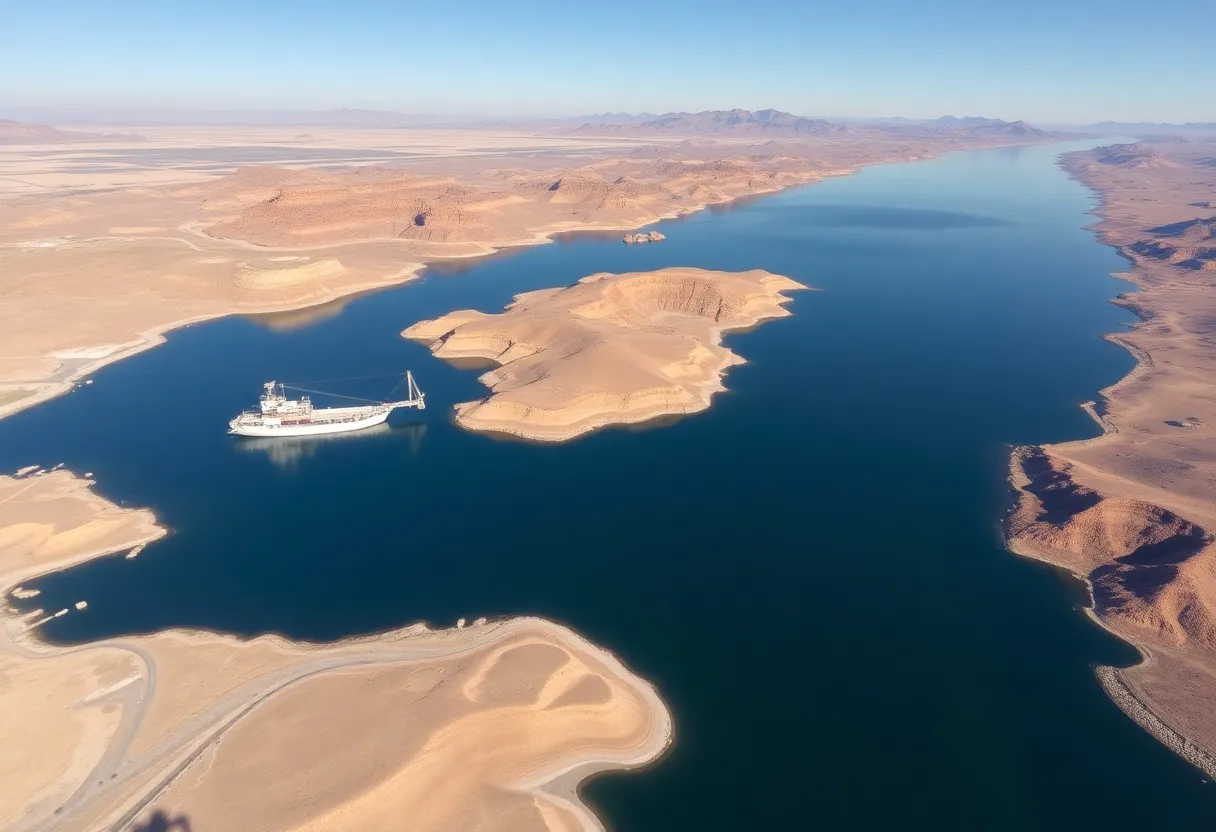News Summary
Lake Mead has seen a significant increase in water levels, rising to 1,075 feet due to winter precipitation and snowmelt. Although this rise offers temporary relief, experts caution that without a solid water management strategy, these levels may not be sustainable. Water allocations for Nevada in 2024 will be reduced, and regional conservation efforts are underway to address ongoing water shortages. The interaction of climate change and environmental factors complicates the situation, emphasizing the need for proactive planning to manage this vital resource.
Las Vegas, Nevada
Water levels in Lake Mead have experienced a significant rebound, rising to 1,075 feet, marking a return to levels last seen in May 2021. This increase follows troubling declines that saw the reservoir drop to a record low of 1,040 feet in July 2022, primarily due to enduring drought conditions coupled with the impacts of climate change.
The recent uptick in water levels can be attributed largely to heavy winter precipitation and the subsequent snowmelt, which significantly boosted water inflows into the lake. Currently, Lake Mead stands approximately 5 feet higher than its previous lowest recorded level. However, despite this temporary relief, experts warn that without a comprehensive and effective water management plan, this elevation could prove to be short-lived.
The Colorado River serves as a vital resource for around 40 million people across seven states, along with sustaining regional agriculture, making its health and water levels particularly critical for these communities. The Bureau of Reclamation forecasts that water levels in Lake Mead may fluctuate dramatically throughout the year, with projections estimating a possible drop of 20 feet during the upcoming summer months. Historical data illustrates that even in years of significant snowpack like this one, drought conditions can result in lower runoff due to factors such as dry soil absorption.
Notably, the snowpack in the Upper Colorado River Basin has exceeded 150% of its historic average due to an unusually wet winter. Nevertheless, ground conditions and overall soil moisture are crucial in determining how effectively this snowmelt translates into runoff into Lake Mead and the wider Colorado River system. This relationship underscores the complexity of water management and the necessity for an adaptable strategy.
Water Allocations and Future Management Strategies
Looking ahead, Nevada’s water allocation for the year 2024 is slated at 279,000 acre-feet, reflecting a 7% reduction from 2023. In response to the ongoing water crisis, Arizona, California, and Nevada have initiated a new conservation plan that aims to save an additional 3 million acre-feet of water by 2026, with financial backing from the federal government.
Despite these efforts, experts emphasize that the Western United States will need a series of consecutive wet years to truly replenish reservoirs like Lake Mead to more sustainable levels. Ongoing negotiations among state officials, tribal communities, and federal entities about future water allocations and management policies will be key moving forward, particularly as the current guidelines are set to expire in 2026.
The Role of Climate and Environmental Factors
As water management strategies evolve, considerations related to wildfire risks are becoming increasingly urgent, as these can complicate runoff efficiency and overall water resource management. The intertwined effects of climate variables highlight the necessity of thorough, proactive involvement aimed at addressing water scarcity and optimizing resource distribution in a time when climate changes tend to exacerbate existing challenges.
The situation surrounding Lake Mead underscores the critical need for data-driven, strategic planning to ensure the responsible management of water resources, particularly in an era characterized by warming temperatures and prolonged dry conditions. Continued vigilance and innovative approaches are essential to navigate this complex landscape as stakeholders strive to secure water resources for the future.
Deeper Dive: News & Info About This Topic
HERE Resources
Las Vegas to Experience Cool Weekend Temperatures
Las Vegas Housing Market Faces Uncertainty with High Prices
Las Vegas Faces Sharp Declines in Hotel Performance
Lake Mead Water Levels Reach Historic Lows
Las Vegas Faces Extreme Heat This Week
Las Vegas Engages in Unconventional Climate Debate
Extreme Heat Wave Hits Las Vegas This Week
Nevada Lawmakers Reassess Water Use Fees Amid Climate Concerns
Las Vegas Records First 100-Degree Day of the Year
Record Rainfall Transforms Las Vegas Wash Water Levels
Additional Resources
- CNN: How Much Lake Mead Water Rise Affects Climate
- Wikipedia: Lake Mead
- The Hill: Lake Mead’s Level Jumps 3 Feet
- Google Search: Lake Mead Water Levels
- Vox: Southwest Water Drought and Lake Mead
- Google Scholar: Lake Mead Climate Change
- Architect’s Newspaper: Federal Government Declares Water Shortage at Lake Mead
- Encyclopedia Britannica: Colorado River
- Newsweek: Trump Loses Battle Over Lake Mead Funding
- Google News: Lake Mead Funding

Author: STAFF HERE LAS VEGAS WRITER
The LAS VEGAS STAFF WRITER represents the experienced team at HERELasVegas.com, your go-to source for actionable local news and information in Las Vegas, Clark County, and beyond. Specializing in "news you can use," we cover essential topics like product reviews for personal and business needs, local business directories, politics, real estate trends, neighborhood insights, and state news affecting the area—with deep expertise drawn from years of dedicated reporting and strong community input, including local press releases and business updates. We deliver top reporting on high-value events such as Electric Daisy Carnival, World Series of Poker, and Consumer Electronics Show. Our coverage extends to key organizations like the Las Vegas Chamber of Commerce and Three Square Food Bank, plus leading businesses in hospitality and entertainment that power the local economy such as MGM Resorts International, Caesars Entertainment, and Las Vegas Sands. As part of the broader HERE network, we provide comprehensive, credible insights into Nevada's dynamic landscape.





